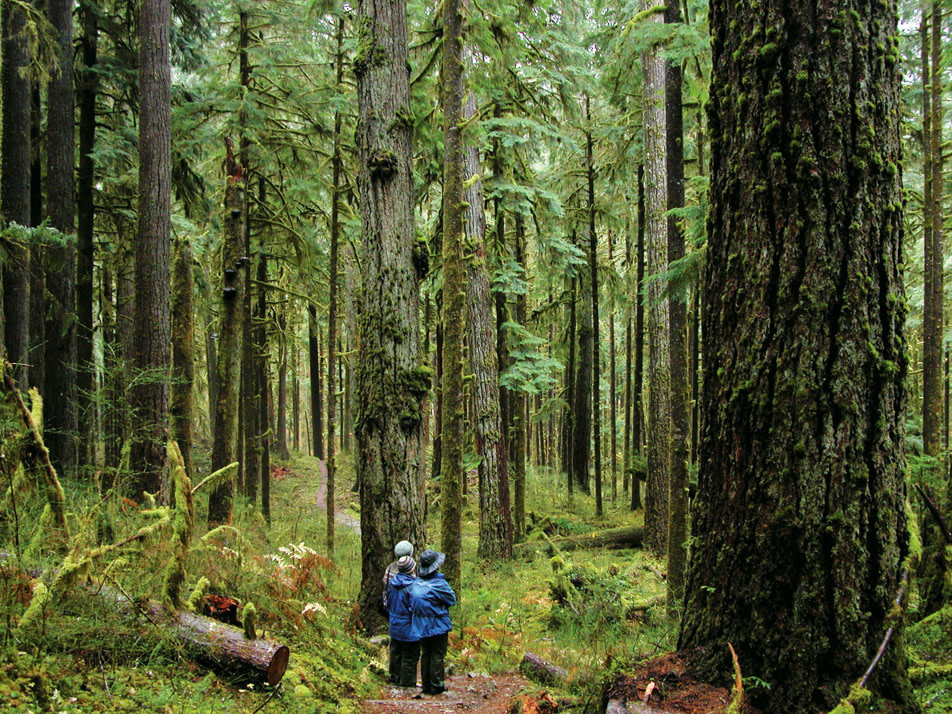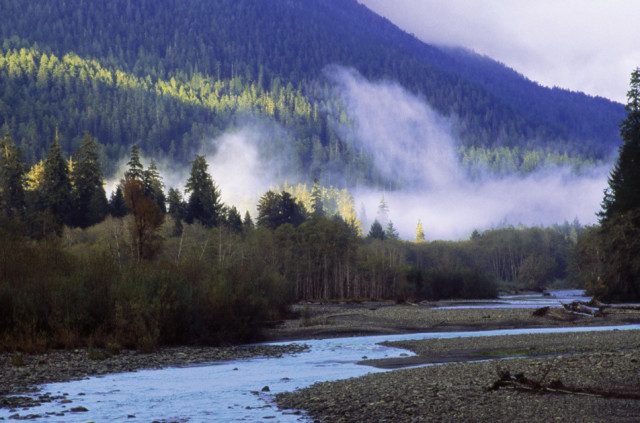The Joys of Old

Taking in nature’s cathedral in the Hoh Rainforest.
By the time I reached Lake Quinault on the southwestern edge of Olympic National Park, it was too late in the day to tackle the Quinault Trail, a 13-miler that carves a narrow path through a waterfall-streaked ravine enticingly named the Enchanted Valley. It was my own fault. I had neglected to pack and fuel up the night before, and now, with the sun already tracking toward the western horizon, I was forced to hike what surely must be the wimpiest trail on the entire Olympic Peninsula, a half-mile interpretive loop called the Rainforest Nature Trail. Elevation gain: zilch.
“It’s really very pretty,” the volunteer at the Lake Quinault Ranger Station cheerily informed me, highlighting a needle-eye-sized trail on a photocopied map. “There are signs that tell you about the forest.”
Mere moments after I left the forest, I was sitting on the lawn sipping a pint of ale.
It wasn’t exactly the grand, inaugural hike I’d had in mind for my four-day romp around the Olympic Peninsula’s western and northern edges. But mere yards from the trailhead parking lot, the forest handily reinstilled some wonder into that jaded part of my brain, for already I found myself smack-dab in the thick of a grove of massive trees between 500 and 700 years old. Vine-maple leaves trembled over Willaby Creek, sunny salmonberries dangled from delicate stems, and betwixt those Douglas firs grew tufts of sword ferns and patches of Oregon oxalis, among hundreds of other mushrooms and mosses and lichens and liverworts.
Even the rust-resistant signs the volunteer had touted managed to hold my interest. They informed me, for example, that the coastal Pacific Northwest between Oregon and British Columbia claims fully 66 percent of the world’s temperate rainforests—that is, rainforests that grow in places that experience winter, as opposed to tropical rainforests, which remain frost-free year-round. The distinction is visible in the forests’ respective flora: Whereas tropical rainforests have more climbing vines, and leaves grow to dinosaurlike proportions, the temperate rainforest is fuzzier, characterized by mosses and plants with smaller leaves. The other 34 percent of the temperate habitat, I learned, lies in narrow strips along the coasts of places like Chile, New Zealand and Australia. That’s it. The whole official planetary inventory.
So rare is this particular ecosystem that people from around the world travel to the Pacific Northwest just to see it. During my stay, I met visitors from Great Britain, Japan, Korea and Germany who had spent many flying and driving hours trying to get here. Yet before I left Portland, I was surprised to find that few friends and colleagues had ever really explored the peninsula, in spite of the fact that the western Olympic National Park’s forests, owing to annual rainfall averaging 12 feet, are far richer than those in the Columbia River Gorge, and in spite of the fact that it takes just three hours by car to reach the forests around Lake Quinault.
But then the peninsula isn’t exactly easy to explore. Scenic roads may dart straight through the centers of national parks such as Yosemite and Yellowstone (making it a cinch for less active folk to hop out, point-and-shoot and move on), but the mountains and forests at the heart of Olympic National Park are accessible only to the hardiest of backpackers, those willing to trek 10 or 20 miles through a wilderness populated by black bears and mountain lions.
The rest of us are left to circle the peninsula—and jockey with logging trucks—on U.S. 101, which mostly wends through U.S. National Forests, many parcels recently buzz-cut or in various stages of regrowth. The few towns survive on timber, not tourism, and thus lack that perky souvenir quality and the nonfried cuisine that most urban travelers prefer. As a result, those who require four-star pampering or are disinclined to get out of the car will find the peninsula has little to offer. But those who are moved by calendar-worthy scenics, big trees, elk sightings and the simple pleasure of walking will find the landscapes among the country’s most awe-inspiring.
And, as the wee trail I completed on that first evening of my visit proves, one need not be superhuman to experience the Olympic Peninsula’s natural bounty. What’s more, mere moments after I exited the forest I was sitting in an Adirondack chair on the lawn of the 1926 Lake Quinault Lodge, sipping a pint of ale and gazing at the low ridges that ring this meltwater-fed, trout-filled lake. The ambience and grandeur of the old lodge are not found so much in the guest rooms, which come in either vintage style (small, with creaky floors and uninspired décor) or new additions (large, with uninspired décor), as in the lobby area, which faces the lake and is anchored by a fine fireplace. It’s here that guests gather nightly to drink wine, play games and chat with strangers. (Dutchman: We saw elk today. Englishwoman: Did you? We saw a mountain lion. Dutchman: No! Englishwoman: Yes!)
The next morning I headed north toward Ozette Lake, stopping briefly at the Hoh Rainforest Ranger Station, the site of a couple short loops and also the start of the Hoh River Trail, which winds for 18 miles to Glacier Meadows, spread out beneath the peak of 7,980-foot Mount Olympus. One trailhead sign warned about the unpredictable personalities of the Roosevelt elk. Apparently, female elk protecting their young have charged and kicked at least one man and two dogs in the Hoh area, though luckily for me—considering that I practically ran into the butt of one that was grazing trailside—the sign said nothing about these wild elk going after women. The doe leaped into a cove of trees and bushes, then kindly stood stone-still while a group of hikers flashed her with their digital cameras.
{page break}

The Quinault River, which feeds Lake Quinault.
But my real goal was the Cape Alava Trail, which begins on the western edge of Ozette Lake and heads 3.1 miles through coastal forest to the edge of the Pacific. What makes this hike one of the peninsula’s best is the fact that it is a boardwalk; Doug fir planks line the path almost all the way to the sea. The entire length of the trail, you are suspended a foot or so above the forest floor, on a winding, moss-edged path, the sort that might lead to the front door of the crooked man who famously lives in a crooked house. If time and tides allow, you can head three miles up the beach and return via a second boardwalk trail, Sand Point, making for a classic nine-mile circuit.
I chose instead to spend some time staring at the sea. The massive rocks you see in Oregon’s Pacific waters tend to be big chunks, but here, it was as if someone had lifted up one of those boulders and let it smash into a hundred bits, leaving them scattered across a shallow bar. Ravens and gulls picked at the tide pools, and the barks of unseen sea lions added an eerie quality to the scene.
You are suspended a foot above the forest floor on a boardwalk.
On a stretch of sand not far from here, archaeologists uncovered a 500-year-old beachfront village once inhabited by ancestors of the Makah Tribe, and my interest in seeing some of the 55,000 artifacts that were miraculously preserved by a mudslide meant a stop at tiny Neah Bay, the commercial and cultural center of the Makah located on the peninsula’s northernmost cape. Perhaps because it is a worn-out, financially strapped fishing town well off the beaten path, Neah Bay is overlooked by many guidebooks (and people), which is too bad since the Makah Cultural & Research Center is one of the most informative museums I’ve visited. Rescued from the mire, spear tips used for whale-hunting and seal-hunting, as well as cooking boxes, clothing and tools, are all on display. You can even hang out inside a life-size replica of a Makah longhouse, which was the spiritual home of the tribe. Another reason for a side tour to Neah Bay is to make the hike to Cape Flattery, reputedly the continental United States’ westernmost cape. The ¾-mile trail ends in a series of platforms overlooking a stunning vista of coastal caves. Birds are everywhere, as are seals. It’s like Cape Meares times 10.
But the very best reason to trek to Neah Bay is to eat the smoked salmon of Kimm C Brown. You’ll find Brown and his Take Home Fish Company in the white shack behind his mobile home just off Bayview Ave, next to the Makah Maiden coffee stand and across the way from the Makah Mini Mart; just look for the white sign with hand-painted “Smoked Salmon” in red letters. Cooked for two to five hours over alder wood, the fish was so juicy, so smoky, that I ate a full pound of it. His secret besides his methodical technique? Buying good salmon in the first place. “You want all the scales to be intact so the oils stay inside,” he says. “I only buy from fishermen who clean the fish right away, so the flesh is firm.” (His other secret is Lawry’s garlic salt, which he buys in bulk.)
My last stop was the 1916 Lake Crescent Lodge on Lake Crescent, a glacial lake on the north side of the park surrounded by ridges that rise so sharply, you feel you are in fact on the edge of a fjord. As with Lake Quinault’s signature accommodation, the best parts of Lake Crescent are the trails that begin mere steps from the lodge (including one that climbs to the top of Mount Storm King) and the stone fireplace in the main reception room, over which hangs a 20-point Roosevelt elk buck. The glassed-in porch makes as fine a place for a cocktail as you’ll find on the peninsula, what with the lake lapping at land mere yards away. I intended to go to Hurricane Ridge, which proffers spectacular views of Olympic summits, and hike out to Elk Mountain, but the clouds came, and then the rain. So I contented myself with the Moments in Time Nature Trail, another wimp, just a half-mile long.
My consolation was that unlike the foreign travelers I met, I would need only a few hours and perhaps a long weekend to return here, which means I didn’t need to be overly ambitious. And I certainly didn’t need to hurry.




